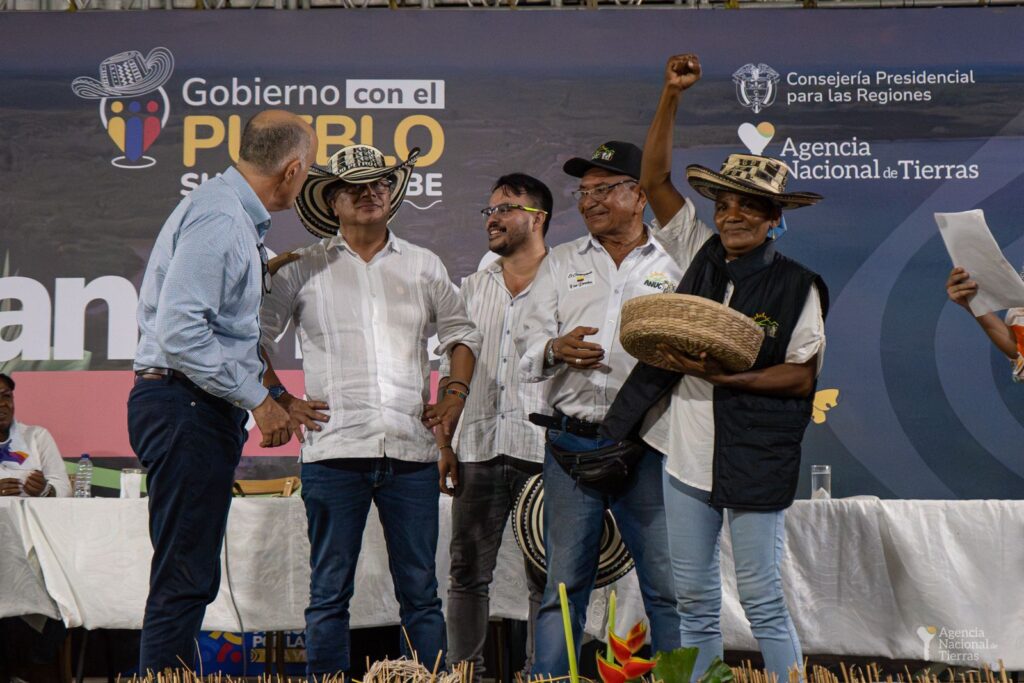
During his five-day tour entitled ‘Government with the People’ (Gobierno con el Pueblo) along the Caribbean Coast from March 18 to March 22, 2024, President Gustavo Petro formally handed over government land to numerous families displaced by illegal armed groups. This initiative is part of the Agrarian Reform, a governmental project launched in 1994 and revived by President Gustavo Petro in 2023 to promote land redistribution among rural communities in Colombia.
Gustavo Petro ‘with the people’
During a ceremony held on March 21, 2024, in San Onofre, Sucre Department, President Petro officially offered several plots of land to vulnerable communities affected by armed groups operating in the region. He was joined by Daniel Rojas Medellin, director of the Special Assets Society (Sociedad de Activos Especiales – SAE), a government agency responsible for managing confiscated assets from illicit activities, and Juan Felipe Harman, director of the National Land Agency (Agencia Nacional de Tierras – ANT), responsible for land redistribution.
As part of the initiative, 1,414 hectares in the municipality of San Onofre were distributed to 130 Afro-descendant families. These lands were voluntarily sold to the ANT by a notable local landowning family. Additionally, 1,384 hectares in the Cordoba department were allocated to peasant families of indigenous and African descent.
This donation includes 409 hectares seized by the ANT and the SAE, which were presented to 30 peasant women who suffered due to the armed conflict. Located in the Ayapel municipality, the Cordoba department, the ‘finca Simba’ lands, these areas were previously controlled by paramilitary groups until 2005, after which they were transferred to Luis Fernando Castaño Alzata, ‘El Botija’, a member of the influential ‘Oficina de Envigado’ crime syndicate. As such, this initiative is part of an agreement between Colombia’s ANT and the SAE to utilize properties seized from criminals to benefit victims of armed conflict.
Land conflict and the Agrarian Reform in Colombia
The Agrarian Reform is a cornerstone of Gustavo Petro’s administration. Originating in Law 160 of 1994, the Agrarian Reform aims at developing the rural areas of the country, particularly through the allocation of land to landless peasants.
Indeed, land ownership disparities are a historic and critical issue in Colombia, as it was a major catalyst for the internal armed conflict that began in 1964. The struggle over land tenure, especially among Afro and indigenous communities historically subjected to slavery or forced labor, gave rise to far-left guerrilla movements challenging the deeply rooted system established during the Spanish colonization. At the conflict’s peak, landowner-formed paramilitary groups forcibly displaced peasants, driving five million people from rural to urban areas. Consequently, Colombia’s land distribution remains one of the most unequal in the world, with half of the land owned by just 1 percent of the population.
Historically opposing paramilitary forces and advocating for peasant communities, President Gustavo Petro has chosen to revive the Agrarian Reform, neglected by prior administrations. Beyond land redistribution, President Petro aims to develop rural areas through industrialization.
See all the latest news from Colombia and the world at ColombiaOne.com. Contact our newsroom to report an update or send your story, photos and videos. Follow Colombia One on Google News, Facebook, Instagram, and subscribe here to our newsletter.

